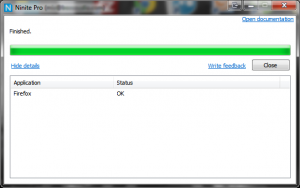
Additionally, the full result of the final audit (including the “Not installed” messages) is saved as NiniteAuditAfterUpdate.log. When the script completes, the NiniteUpdateSummary.log file is written to stdout (which is what is displayed in the MAXfocus dashboard). “Not installed” messages are omitted, so you get a nice summary of what is installed. Output is written to the NiniteUpdateSummary.log file in the same folder as the script.

Ninite is run three times: first in /audit mode, then in /updateonly mode, then again in /audit mode. NiniteUpdate.cmd "%SystemDrive%\Scripts\Helpers" "\\SRV01\NiniteDownloads" Behavior Defaults to %temp%\NiniteDownloads if not specified. This can be on a network share, in which case the MAXfocus agent must run as a user with network access (not as the default SYSTEM account). Param 2 Optional path to a NiniteDownloads cache.

Param 1 Path to local or network copy of NiniteOne.exe. This is especially useful when run from the SolarWindows RMM dashboard as a Scheduled Task: the output is visible from the dashboard. I’m running it in silent mode but I wanted some decent logging so I can review what it did. I’ve deployed Ninite Pro to update non-Windows applications on computers that I manage.


 0 kommentar(er)
0 kommentar(er)
